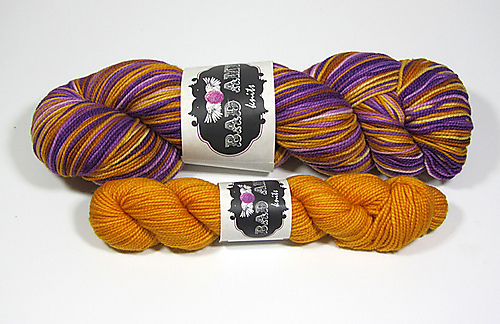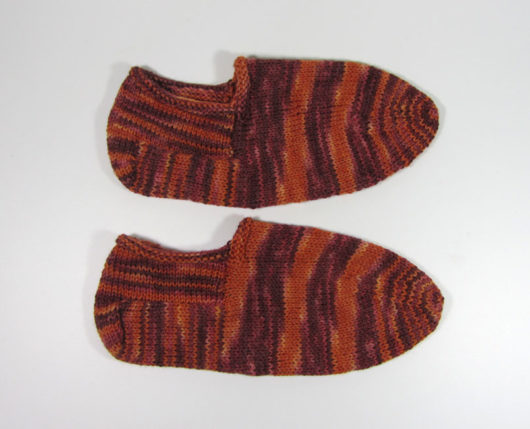These are Susan B. Anderson’s top-down Smooth Operator Socks. Actually they are my socks, but you know the drill. Anderson designed them. I knit them. And, in this case, Bad Amy is the yarnie whose work gave these socks their pizzazz.
I’d used the gold of the Bad Amy yarn set on another project and wanted to find a pattern that would make the self-striping yarn look its best, even without a gold toe and heel. Smooth Operators fit the bill perfectly. The design is meant to help self-striping yarn do its striping best. The pattern helps you to plan for two identical socks. I succeeded, except for the heels. And, more important than two perfectly matched socks, the afterthought heel assures that the striping isn’t interfered with on the front of the sock while a knitter is busy knitting the heel.
Honestly, I am concerned that these heels won’t hold up well. I prefer a heel with slipped stitches to help durability. But, for looks, this pair gets high marks. I am planning to wear them with sandals to try to avoid having to darn the heels. Hmm. That would be a neat trick. Darning, that is. I’ve never darned socks. I’ve watched videos on how it’s done. That’s as close as I’ve come.
My Smooth Operators followed on the heels of another recent sock escapade. My escapade started with this beautiful skein of Socks That Rock.
I go limp in the face of pink and spring green. And those blue splotches looked so good in the skein.
Well. That’s a fine howdy-do. I nominate these for the worst-pooling-ever award. I can’t and won’t fault the pattern, which is Churchmouse Yarns & Teas’ Basic Socks. It’s an excellent basic sock pattern. In fact, if you’ve not knit socks before and want to try sock-knitting, this is an excellent pattern because the directions are extremely detailed. Don’t hold these socks against that pattern.
Maybe if I scrunch them up a bit they’ll become less awful.
No. I will still wear these socks. It’s great yarn. If we meet up at Freddy’s you will know me by my socks. There won’t be another pair of these anywhere else except on my feet.
This next bit of footgear worked out much better. A different variegated yarn stood up well to a different Churchmouse pattern, Turkish Bed Socks. Mine are knit in Yarn Hollow Squish, an interesting fingering weight in 60% Wool, 30% Rayon from Bamboo, and 10% Nylon. I don’t know what Rayon from Bamboo is all about, but Squish is excellent yarn. I had a partial skein from a cowl kit that didn’t work out for me, so I repurposed it for these bed socks.
I’ve knit these before. They do not disappoint and look great in self-striping yarn.














